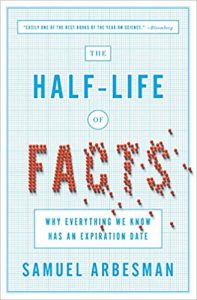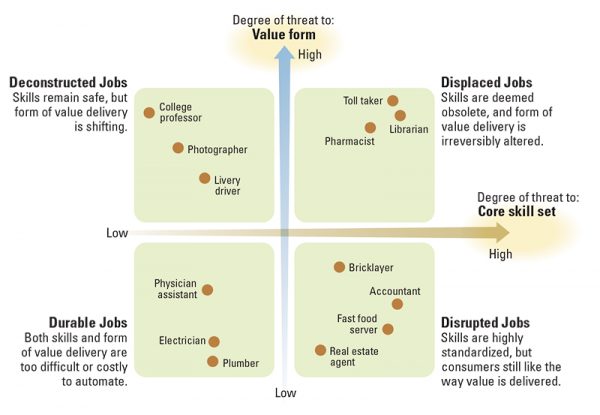This is a page of the first FREE section of the MWL 2020 resource; there are 25 sections in all. You can purchase access to the full resource HERE
← Full Contents | Section 1 Contents
Up to now, the main rationale for Modern Workplace Learning has been the need to support a more diverse approach to learning at work. But here are 3 further reasons why Modern Workplace Learning has now become a necessity.
1 – Information explosion and decay
The first of these forces concerns information explosion and information half-life.
In his 1982 book, Critical Path, futurist and inventor R. Buckminster Fuller estimated that up until 1900 human knowledge doubled approximately every century. By 1945 it was doubling every 25 years, and by 1982 it was doubling every 12-13 months. IBM estimates that in 2020 human knowledge will be doubling every 12 hours. In The coming knowledge tsunami, Marc Rosenberg showed this diagrammatically as below.

 But although information itself is growing exponentially, the half-life of knowledge (or facts) is decreasing. Wikipedia defines this as follows …
But although information itself is growing exponentially, the half-life of knowledge (or facts) is decreasing. Wikipedia defines this as follows …
“The half-life of knowledge or half-life of facts is the amount of time that has to elapse before half of the knowledge or facts in a particular area is superseded or shown to be untrue.”
 In other words, as Samuel Arbesman explains in his book, The Half-Life of Facts: Why Everything We Know Has an Expiration Date …
In other words, as Samuel Arbesman explains in his book, The Half-Life of Facts: Why Everything We Know Has an Expiration Date …
“Over time, one group of facts replaces another. As our tools and knowledge become more advanced, we can discover more — sometimes new things that contradict what we thought we knew, sometimes nuances about old things. Sometimes we discover a whole area that we didn’t know about.”
And, in Half Life: The Decay of Knowledge and What to Do About It, Shane Parrish provides a good example.
“While figures for the half-lives of most knowledge-based careers are hard to find, we do know the half-life of an engineering career. A century ago, it would take 35 years for half of what an engineer learned when earning their degree to be disproved or replaced. By the 1960s, that time span shrank to a mere decade … Modern estimates place the half-life of an engineering degree at between 2.5 and 5 years.”
According to some the half-life of skills is also diminishing fast, with some skills having only an 18-month window. Knowledge and skills now have such a short shelf-life that it is frequently said that a college degree will be out of date before the loan is paid off.
Shane Parrish shows that the decreasing half-life of knowledge means that lifelong learning is imperative by using the example of the decreasing half-life of an engineering degree.
“In 1966 paper entitled “The Dollars and Sense of Continuing Education,” Thomas Jones calculated the effort that would be required for an engineer to stay up to date, assuming a 10-year half-life. According to Jones, an engineer would need to devote at least five hours per week, 48 weeks a year, to stay up to date with new advancements. A typical degree requires about 4800 hours of work. Within 10 years, the information learned during 2400 of those hours would be obsolete. The five-hour figure does not include the time necessary to revise forgotten information that is still relevant. A 40-year career as an engineer would require 9600 hours of independent study. Keep in mind that Jones made his calculations in the 1960s Modern estimates place the half-life of an engineering degree at between 2.5 and 5 years, requiring between 10 and 20 hours of study per week.”
He therefore comes to the conclusion:
“The faster the pace of knowledge change, the more valuable the skill of learning becomes.”
Some educational institutions recognise this, as the author of The impact of the half-life of facts on education explains.
“Medicine acknowledges the problem of the change of knowledge. Doctors are taught that much of what they learn will be obsolete in a few years of graduation, and they must always devote time to the latest changes in their field.
It’s not just about constantly learning new facts, but having the resources to understand how those facts will change and be on top of the information needed to function in the world.”
But, as Shane Parrish points out
“The problem is that we rarely consider the half-life of information. Many people assume that whatever they learned in school remains true years for decades later.”
The implications for the world of work are immense: individuals will need to be constantly replacing out-of-date knowledge with new knowledge in a continuous process of unlearning and learning
2 – Automation
 Technology has been an organisational disruptor for some time now, but it is automation (that is the use of Artificial Intelligence and Robots) that is now being hailed as the next big game-changer.
Technology has been an organisational disruptor for some time now, but it is automation (that is the use of Artificial Intelligence and Robots) that is now being hailed as the next big game-changer.
Many foresee the widespread adoption of the technology will have a profound effect on the world of work. In fact, there have been many newspaper articles that talk about the numbers of jobs that will be replaced.
But although some jobs will be replaced by automation, it will also create new ones. Furthermore, it is likely that many more will be changed in some way by automation, which is a more significant issue, as the October 2017 Futurism report, The Reports Are In: AI and Robots Will Significantly Threaten Jobs shows:
“A startling scenario the report envisions for the future is one in which “typical” jobs — jobs people can steadily advance in through promotions — no longer exist, prompting the aforementioned move to develop new skills.
“A report suggests people only have five years before automation and AI threaten jobs and force them to learn new skills for the workforce. The firm PwC surveyed 10,000 people from around the world, revealing people are concerned about automation, but they’re also willing to learn.
“It varies a bit by industry,” explains Hesse, “but over the next five years we’re going to see the need for workers to change their skills at an accelerating pace.” If the report’s results are anything to go by, people are ready for change: 74% expressed a willingness to “learn new skills or completely retrain in order to remain employable in the future.”
The implications for both employees and organizations are clear. Individuals will need to learn new skills to remain employable, and organisations will need to ensure they have individuals with the relevant skills to remain competitive in their market. Anne Lise Kjaer, a futurist, sums it up well.
“The world is changing; complexity in society and business growth is changing the future of jobs and skills. Evolving technologies, notably robotics and Artificial Intelligence (AI) are driving automation of ever more traditional jobs and rewriting the rules of education and skills. To this end, individuals as well as organisations will need to adopt a growth mindset and nurture the creativity, agility and lifelong learning skills that will make us, not just resilient, but thriving as the world changes.”
But which jobs are likely to be disrupted? Scott Latham and Beth Humberd in a MIT Sloan Management Review article, Four ways jobs will respond to automation, believe that threats should be assessed along two dimensions: How replaceable the core skill sets are, and how much of a shift there is in the way value is delivered (see diagram below). This will have implications for how to prepare for the future.

How likely is it that a robot will take your job? Take the robots job test.
3 – There is no longer such a thing as a job for life

The book, The 100-year Life: Living and Working in an Age of Longevity, written by Lynda Gratton and Andrew Scott, professors at the London Business School – shows us that individuals are now living longer than ever, and that as life expectancy continues to rise many people will be routinely working for 60 or 70 years.
A subsequent MITSloan Management report, The corporate implications of longer life, written by The 100-Year Life authors, explains how few organizations have come to grips with the opportunities and challenges that greater longevity brings.
One of the implications is that the traditional 3-stage model of education-work-retirement will no longer apply, and will be replaced by a multi-staged model, where there are a variety of ways to arrange the steps – as shown in the diagrams below.

“the flexible nature of the modern workforce will likely see a 15-year-old today navigating a portfolio of 17 jobs in 5 different industries.”
It is also thought that individuals will change specialisations more than once over their career. This will mean building a portfolio of skills over a collection of experiences that will in turn support multiple careers, and
“as working lives become longer, the need for lifelong learning will increase. As working lives become multi-staged and the sequence of those stages becomes more customized, individuals will take an interest in skills with value that extends beyond the current employer and sector.” his will weaken the one-size-fits-all approach to learning and development. Instead, there will be a growing need for more decentralized and flexible approaches to learning, curated more by individuals than by employers.”
The report recognises this will cause a number of tensions in the workplace:
- people want personalization; corporations want conformity
- people want flexibility; corporations want standardization
The authors conclude
“We expect the pressure building from these tensions to grow in the years ahead. Without changes in corporate policies, employees will struggle to build working lives that have resilience over an extended period of time and that support healthy and prosperous longevity. In response, companies need to initiate a top-to-bottom redesign of their human resource practices and processes.”
This is the reality of today’s ever-changing world and poses new challenges to all – both organisations and individuals.
To support these new challenges we need a new approach to enabling and supporting learning at work: Modern Workplace Learning.
Here’s the full contents list of this resource
Last updated: October 14, 2020 at 12:39 pm